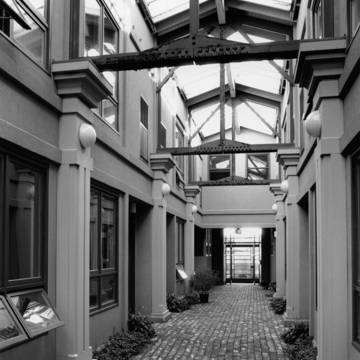As a municipally owned farmers’ market, City Market reflected two Progressive Era impulses: a trend toward expanding municipal services and the nationwide City Beautiful Movement to enhance urban aesthetics. It replaced the informal and, some felt, unsightly stands that individual farmers set up every day along the downtown streets to peddle their produce. When critics labeled the new market “socialistic,” Mayor Joseph Schubert responded, “If bringing the government closer to the needs of the people was socialistic it was just what the people were entitled to.” As the building was going up, the Wisconsin State Journal praised its design as “the most artistic piece of property owned by the city.” The architect, who had apprenticed with Claude and Starck, produced a Prairie Style building of cream and red brick, with a low-pitched hipped roof with deep eaves, windows forming horizontal bands, and stringcourses. A driveway originally ran through the building so that farmers could unload their wagons under the shelter of the roof. The building also incorporated a lounge for women and a smoking room for men—a gendered segregation of public spaces that was common for the day.
In 1987, the Alexander Company rehabilitated the market into an apartment building, one of many efforts to foster a vibrant downtown by encouraging people to live there.


